/ News
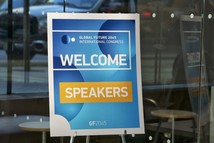
A Review of the Second International Global Future 2045 Congress in New York City
Global Future 2045: Towards a New Strategy for Human Evolution
by Randal A. Koene, Science Director, 2045 Strategic Social Initiative
In June 2013, the Initiative hosted GF2045, the Global Future 2045 International Congress: Towards a New Strategy for Human Evolution, in New York City. The strategy, as Itskov pointed out, involve an ambitious big-picture project called Avatar to enable the transfer of individual personality into sophisticated artificial carriers.
The 2045 Strategic Social Initiative founded by Russian entrepreneur Dmitry Itskov aims to build and carry out a new strategy for the development of humanity that addresses global challenges to human civilization. The future vision emphasizes great spiritual, cultural, ethical, scientific and technological values. Long-term survival of our species and civilization is paramount, but a fundamental question is also where to does our civilization can develop? The new strategy embraces the uniting of biological and non-biological development of humanity and the advent of the cybernetic age. In June 2013, the Initiative hosted GF2045, the Global Future 2045 International Congress: Towards a New Strategy for Human Evolution, in New York City. The themes of the congress included android bodies, brain-computer interfaces, cognitive neuroscience, mind engineering and more.

The strategy, as Itskov pointed out, involve an ambitious big-picture project called Avatar to enable the transfer of individual personality into sophisticated artificial carriers. Such an accomplishment will reduce human suffering, extend healthy life-span, and free-up our attention to address challenges beyond our mortality, so that we may engage in the creation of new meaning and goals. It will facilitate a transition from hunger to abundance, from national tension and war to the freedom to create and to concentrate on (spiritual) self-improvement. Natural selection enabled life on Earth, more rapid adaptation through technology will bring it to the Cosmos. The Initiative works transparently and, in order to involve the global population, does so in dialogue with the world's cultural and spiritual traditions. For this purpose, Dr. Robert Thurman, Professor of Indo-Tibetan Buddhist studies at Columbia University, opened anInterfaith Dialogue about Science, Spirituality, Evolution of Humanity and the Avatar Project at the congress. Participants were Mahayogi 'Pilot' Baba, Yoga master, Dr. Alan Brill, a Rabbi and Professor at Seton Hall University, Dr. William Bushell, Fellow at Harvard University, Phakyab Rinpoche, Tibetan Buddhist Lama and Lazar Puhalo, retired Orthodox Archbishop of Ottawa.

Global crises demand global solutions
The growth of humanity certainly has had desirable consequences: Our population and technology directly affects the rate of creative and scientific output; our economic strength can be brought to bear on issues and projects as ambitious as sending space-probes beyond our solar system or probing the secrets of the universe by smashing particles in super-colliders. But, growth also involves phase-changes in the complexity of society, and that global crises threaten our entire species. The resources required by growth eventually outstrip a limited environment. A large population has a high chance of epidemics, while current social structures combined with competition for resources is likely to lead to conflicts. Earthquakes, tsunamis, drought, flood, as well as disasters of our own making strike portions of humanity everywhere on the globe. In the long-term, humanity faces cataclysmic threats such as asteroid impact. The specter of extinction looms, because our biology is fragile and depends utterly on a finely-tuned environment.

Dr. James Martin, founder of the Oxford Martin School at Oxford University
The late Dr. James Martin, founder of the Oxford Martin School at Oxford University, brought this realization to GF2045 in his talk, The Transformation of Humankind - Extreme Paradigm Shifts Are Ahead of Us. According to Dr. Martin, the effects of industry and population growth on our environment are now close to irreversible, and we should employ technologies and strategies that can avert the worst consequences. Dr. Martin's recent passing is itself a stark reminder of the devastating effects when death suddenly takes our champions and experts. In, The Goal of Biotechnology is the End of Death, Dr. Martine Rothblatt, Founding CEO of United Therapeutics, addressed the taboe around discussions that biotechnologies ultimately aim at ending death. Biotechnologists undertake to cure diseases, and because death is generally the victory of disease over life, the ultimate goal of biotechnology is the end of unwanted, non-violent and non-accidental death.
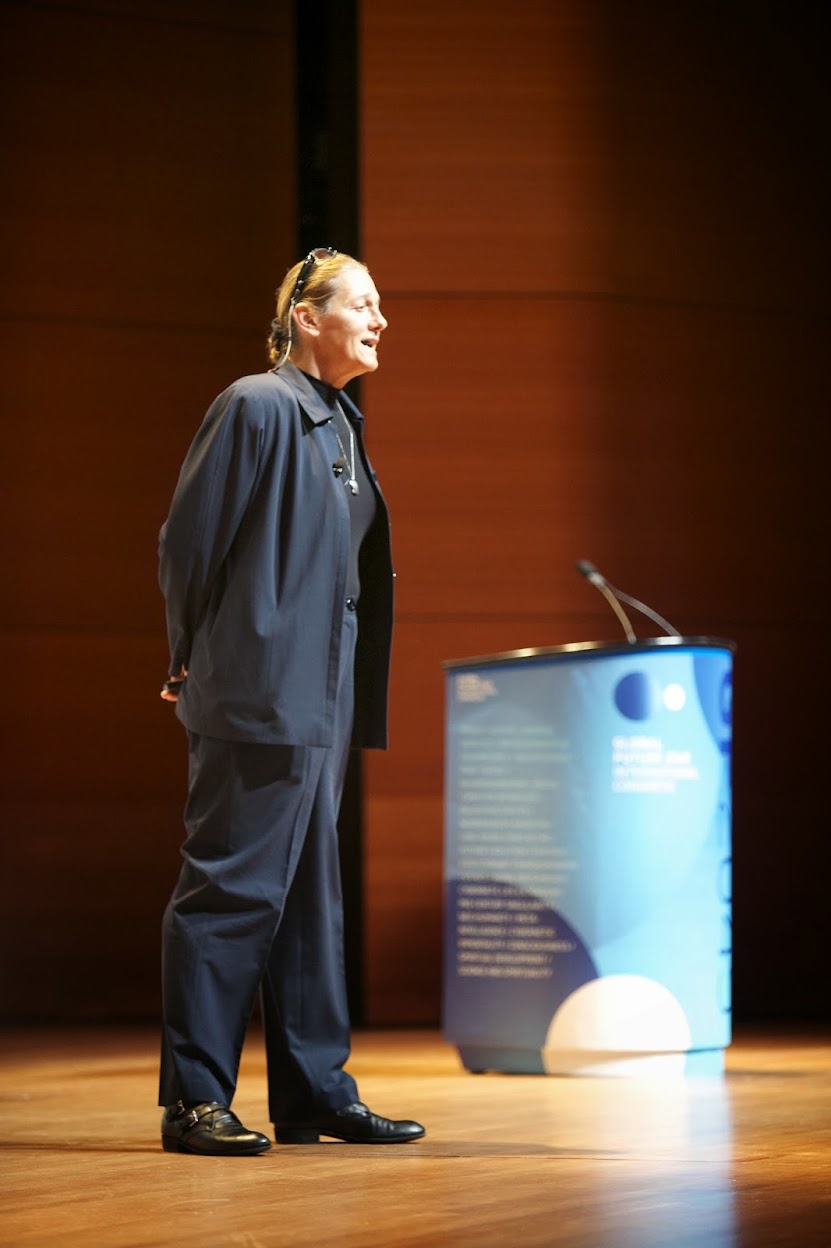
Dr. Martine Rothblatt, Founding CEO of United Therapeutics
Evolving our civilization
The interactions in our growing population become more complex as we transition from family, to tribe, to village, city, nation, and global society. Methods that worked at earlier phases then lead to problems, such as the rift between the haves and the have-nots. To solve these problems, as well as existential risks, suffering through incapacity, decrepitude and death is a moral obligation.
During past physical and social crises, society has had to mature and reinvent itself, a selection process within a developing civilization. Dr. David Dubrovsky, head scientific advisor at the Russian Academy of Sciences Institute of Philosophy, described the influence of biological biases and limitations that lead to excesses and exacerbate global problems, inHuman Nature, The Anthropological Crises and the Global Future. Traditional remedies and politics attempts at sustainable development are short-sighted and narrow of scope.
Evolution is gradual, but natural selection is fast! It consists of a never-ending series of life-and-death trials, survived not by those whose biology adapts, but by those lucky enough to already be suited to the challenge. For each winner of natural selection there are many dead losers and dead ends piled in eons-old heaps of carnage and suffering.
Mr. Itskov explained that the primary objective of the 2045 Initiative is to invest in a positive transition to a future beyond current crises and suffering while saving lives. That does not substitute for sustainable development, but it addresses its logical broader requirements. The Initiative depends on solid scientific fundamentals and the speakers at GF2045 methodically demonstrated grounding in realistic goals and technological feasibility, as well as technological components already being implemented.
Evolved adaptation or engineered adaptation
Biological systems are extremely sophisticated, yet they are not designed for easy access, diagnostics, back-up, restoration or modification to new challenges. The impact of X-Ray, MRI and similar technologies on the treatment of bodily injury is hard to overestimate. Unfortunately, those cannot solve problems in the brain where specific and microscopic differences within the neural tissue are crucial. So, there is as yet no way to restore the minds of patients who suffer from stroke, Alzheimer's, etc.
A most human characteristic is that we augment our selves through technology. We can adapt and engineer evolutionary fitness through our augmentations from spears to pacemakers. Biological evolution does not allow humanity to keep up with the pace of social and environmental change. If we are able to migrate our personalities to an implementation where access, restoration and adaptation are easily possible then that substrate-independence gives us far more than just extended life and health. In her talk, Substrate Autonomous, Networked Avatar Bodies by Design, Dr. Natasha Vita-More, Professor at the University of Advancing Technology in Arizona, explained that she envisions competition between designers and engineers to build whole-body prostheses.

Dr. Natasha Vita-More, Professor at the University of Advancing Technology in Arizona
Great purpose and possibility
Developments can come about in different ways. Selective pressures can act on a near-chaotic consumer society, but we can also apply the power of knowledge and reasoning to exceed the performance of simple action-reward behavior. A historic vector of human development with transitions, separated by logarithmically decreasing time-intervals was demonstrated by Dr. Akop Nazaretyan, Director of the Eurasian Center for Big History and System Forecasting in his talk titled The Mid-21st Century Puzzle: On the Cosmic Perspective of Mind. Dr. Peter H. Diamandis, Founder and Chairman of the X Prize Foundation, proposed a next phase in his talk,Intelligent Self-directed Evolution Guides Mankind's Metamorphosis Into An Immortal Planetary Meta-intelligence.

Dr. Peter H. Diamandis, Founder and Chairman of the X Prize Foundation
Humanity can exhibit great will and exert immense effort, e.g., liberation during World War II, reaching the moon, or closing the hole in the ozone layer. We should acknowledge our capabilities, and the great engine that is humanity needs to be aimed at a great purpose, for which the 2045 Initiative proposes theAvatar project. Looking at being ethically proactive about the 2045 Avatar project and questions of death and identity in his talk, Making Minds Morally: the Research Ethics of Brain Emulation, Dr. Anders Sandberg, James Martin Research Fellow at the Future of Humanity Institute at Oxford University, added, “[...] the future had better be a good place.” So, “[…] the methods we're going to use to get to the future had better be good as well.”
Our experience of being, personal identity and consciousness depend crucially on individually unique mental processes. We need to free the mind from its one, fragile and difficult to restore substrate. In his talk, Facing the Future, Dr. Marvin Minsky, Artificial Intelligence (AI) pioneer, Toshiba Professor of Media Arts and Sciences at M.I.T., made it clear that there is no theoretical objection to the possibility to copy the human mind into other functional platforms. The possibility of transferring mind and consciousness to another carrier, as well as the outlook for life in a cybernetic body, were further discussed in Mankind's Desirable Future According to Vedic culture and Cybernetic Technologies: The Evolution of Consciousness in Vedanta Philosophy, a talk by Swami Vishnudevananda Giri Ji Maharaj, Yoga Master and Founder of the Worldwide Society of Laya Yoga.
Augmenting by integrating technology
For decades we have been off-loading mental tasks to computers. Performance has improved exponentially, as expressed in Moore's Law and the Snooks-Panov algorithm, as explained by Dr. Alexander Panov, Senior Research Fellow at the Physics Department of Moscow State University in his talk, Technological Singularity and the Penrose Theorem on Artificial Intelligence. It is important to note that mental processes can also be expressed through information analysis. Ray Kurzweil, futurist and Director of Engineering at Google, supported this insight in his talk, Immortality By 2045, by pointing to the significance of pattern recognition in mental functions.
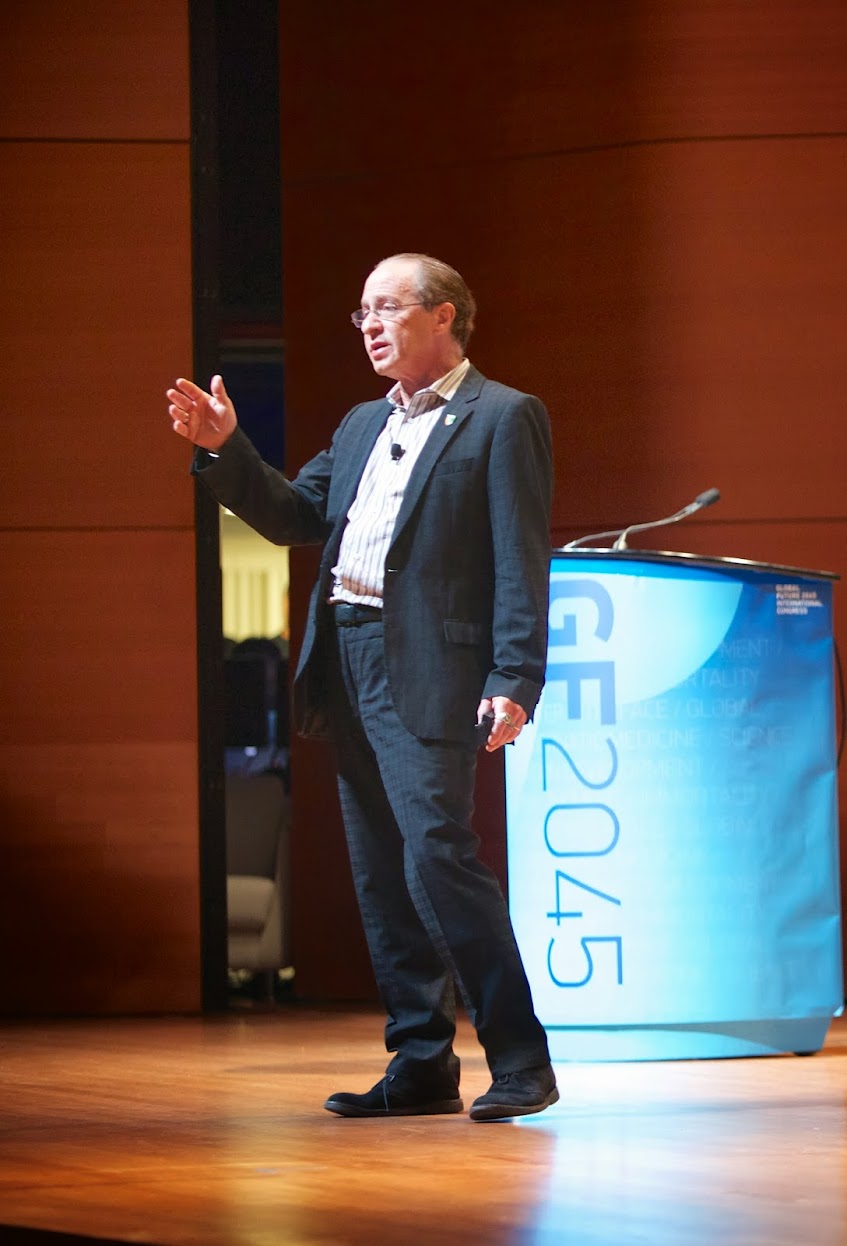
Ray Kurzweil, futurist and Director of Engineering at Google
Further integration by tools based on biological and non-biological technology was presented in the talk,Bionanotech for Extending Moore's Law, the BRAIN Project I/O & Human Genome Engineering, by Dr. George Church, Professor of genetics at Harvard Medical School: efficient genome and epigenome engineering; nanorobots based on hybrid materials (DNA, protein & inorganic); hybrid nanostructures for the manufacture of ultra-fast and complex computing; and bionano storage a billion times more compact than conventional digital media.
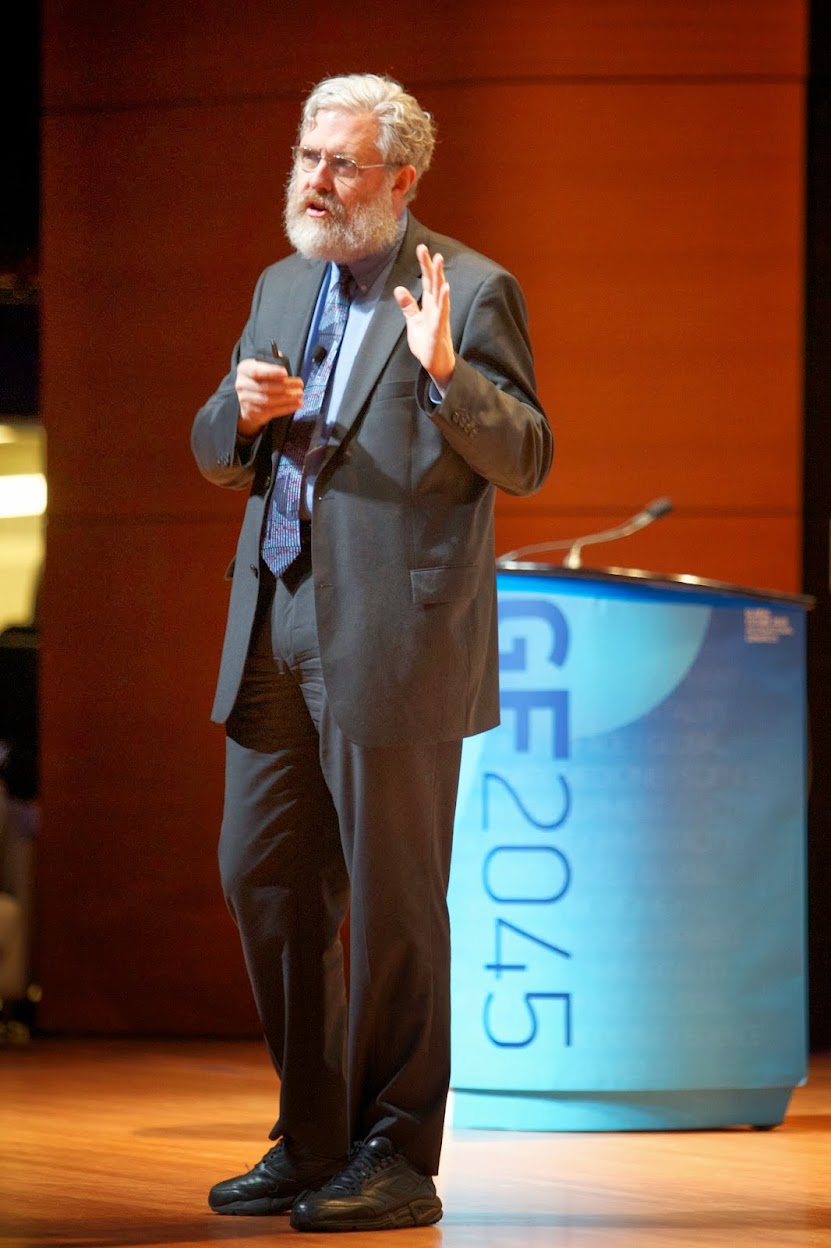
Dr. George Church, Professor of genetics at Harvard Medical School
Brain-controlled prostheses
We are rapidly entering an era of more direct control and feedback. Nigel Ackland, who lost his right arm in a 2006 metal smelting accident, vividly described his extraordinary and life-affirming experiences after he was fitted with the BeBionic3 Myoelectric Prosthetic Hand by RSLSteeper in England. His physical demonstration at GF2045 included such feats as tying his shoe laces.
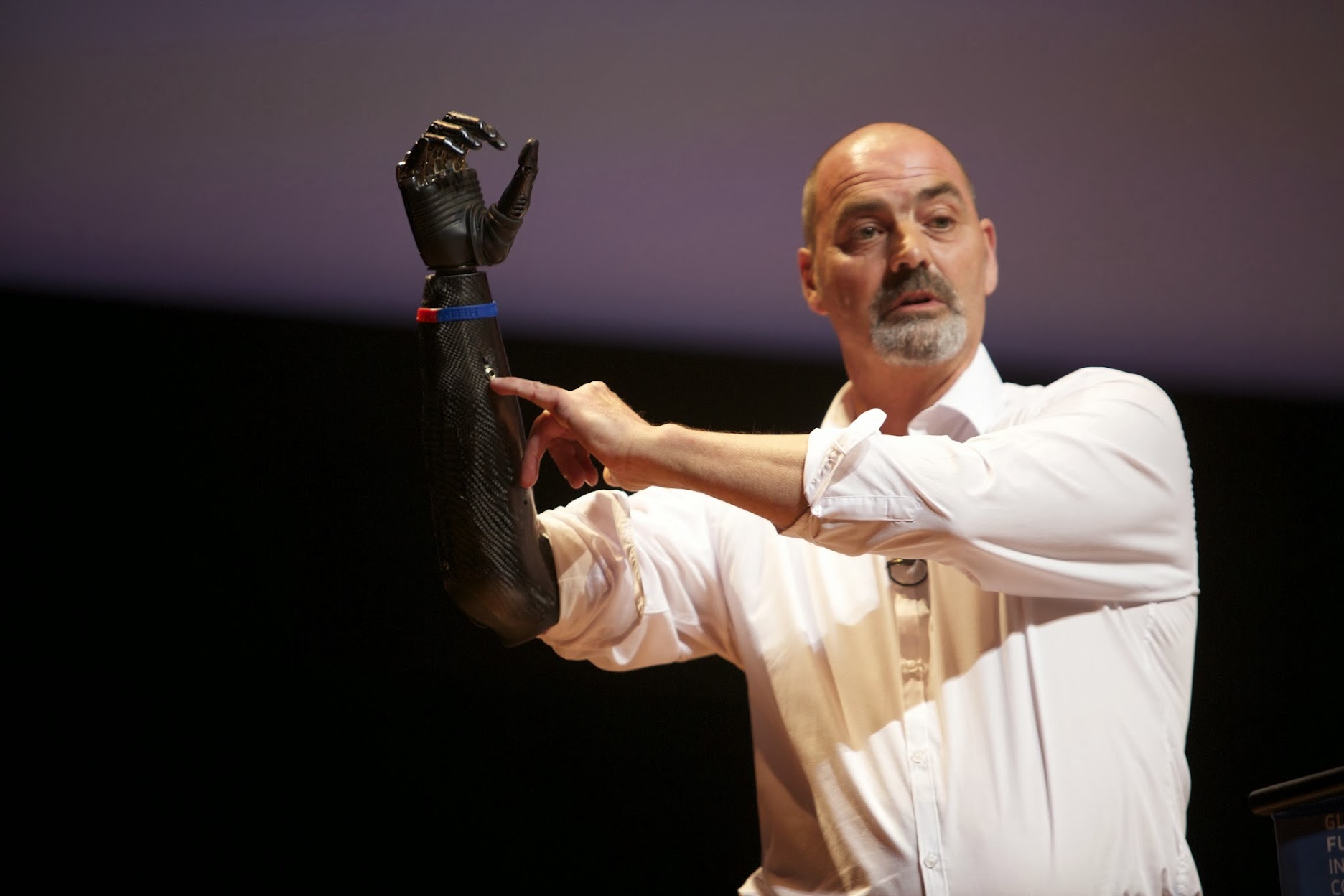
In Brain Control of Prosthetic Devices: The Road Ahead, Dr. Jose Carmena, UC Berkeley Associate Professor of Electrical Engineering and Neuroscience, described highly successful examples: cochlear implants that restore hearing and deep-brain stimulators that invasively, but safely, treat a host of conditions. Experimental BMI enable paralyzed persons to control a robotic arm, to which Carmena remarked, “The field of BMI emerged primarily with this application in mind, basically to convert thought into action.” But, at present the bandwidth of the interfaces lags behind the number of parameters that sophisticated robotics make available.

Dr. Jose Carmena, UC Berkeley Associate Professor of Electrical Engineering and Neuroscience
From anthropomorphic robotics to full-body prosthesis
Continuing these developments, it will be possible to restore mobility to paralyzed patients and to treat those where body (but not brain) is medically incurable. Today's we can furnish patients with telepresence robots, and eventually anthropomorphic robotic bodies, enabling a full-body prosthesis. In his talk, The Future Life Supported by Robotic Avatars, Dr. Hiroshi Ishiguro, Director of the Intelligent Robotics Laboratory in Osaka, Japan, explained that our sensation of “presence”, can be reproduced through android technology. He demonstrated one of his Geminoid Teleoperated Androids, a replica of himself. Dr. David Hanson, Founder of Hanson Robotics, focuses on realistic and emotional robotic faces. Dr. Hanson is constructing the most advanced anthropomorphic robotic head and facial control in a replica for Mr. Itskov.
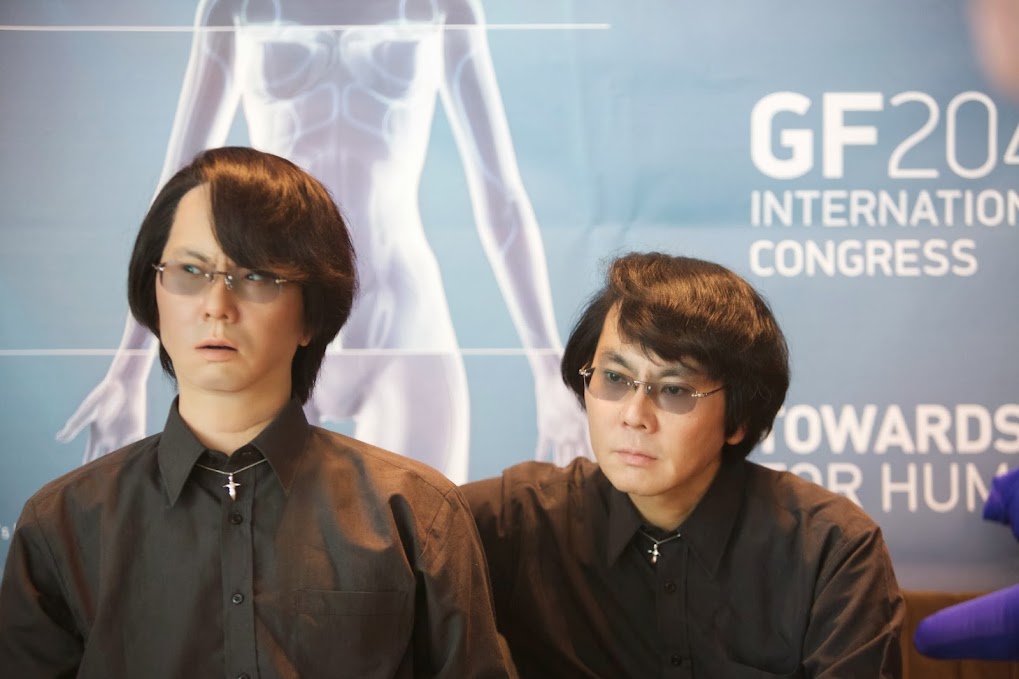
The requirements for maintaining the life-support of a patient's head or brain, and the consequent technical feasibility of a full-body transplant by experiencing life through an artificial body were presented and discussed in a Roundtable on Life-extension of the Brain in a Full-body Prosthesis with Biological Blood Substitutes and Brain-Computer Interfaces with Optional Neuroprostheses. The Roundtable included Dr. Alexander Kaplan, Founder of the first Russian BCI laboratory, Dr. Mikhail A. Lebedev, Senior Research Scientist at the Duke University Center for Neuroengineering, and Dr. Theodore Berger, Professor of Biomedical Engineering and Neurobiology, and Director of the Center for Neural Engineering at the University of Southern California.

Neuroprostheses: Replacement parts for the brain
The majority of my personal scientific efforts are focused on the part of the Avatar project that involves the transfer of individual personality into artificial carriers for the mind. Therefore, Mr. Itskov's Iniative invited a group of speakers with the specific intention to systematically explain work on neuroprostheses and on each of the crucial technology pillars of a roadmap toward Whole Brain Emulation (WBE), a realizable path toward substrate-independent minds and personality transfer.
As bandwidth requirements increase and more devices need to be connected, interfaces must understand how to decode the signals of neuronal circuits within the brain. Currently, this problem is being addressed where the goal is a cognitive neural prosthesis that maintains functions within the brain. Dr. Theodore Berger received a well-deserved standing ovation at the congress for his keynote Engineering Memories: A Cognitive Neural Prosthesis for Restoring and Enhancing Memory Function, where he presented his successful work on a bio-mimetic VLSI implementation that carries out input-output mappings in the manner of the hippocampus. He explained, "[…] to replace neural circuitry in the brain […] requires artificial reconstruction of neuron-to-neuron connections in a way that can be recognized by the remaining normal circuitry [...]" The device detects and produces temporally encoded neural activity, as used to encode short-term memory representations. Dr. Berger showed that neural prostheses can restore and even enhance cognitive, mnemonic processes. His device, which may be used to treat Parkinson's, Alzheimer's and possibly epilepsy will enter human trials within the next few years.
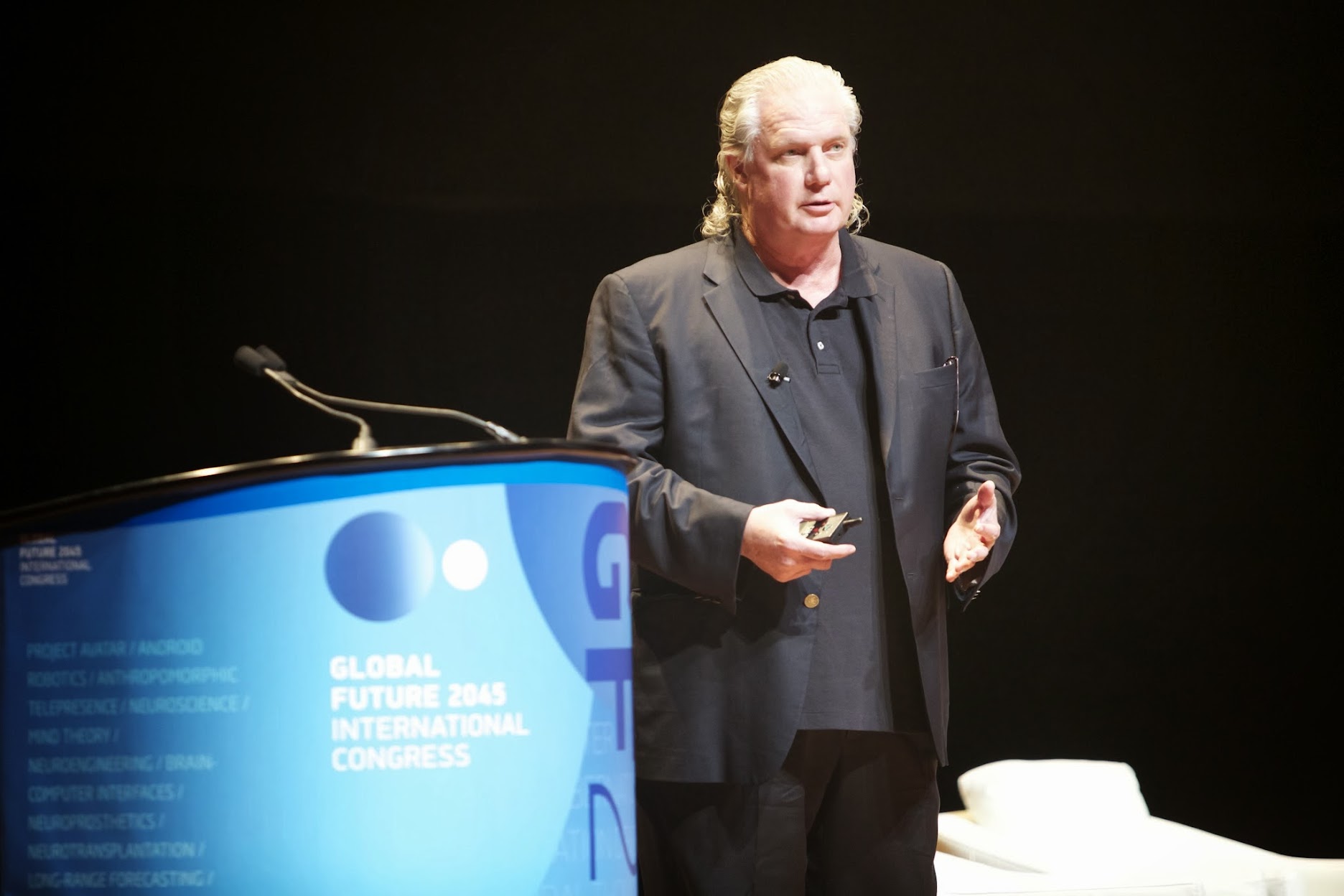
Dr. Theodore Berger, Professor of Biomedical Engineering and Neurobiology, and Director of the Center for Neural Engineering at the University of Southern California
Whole Brain Emulation and Avatar
Dr. Randal A. Koene, Science Director of the 2045 Initiative, presented Whole Brain Emulation: Reverse Engineering A Mind, that connected the threads of each of the neuroscience talks at GF2045. A person's sense of “being”, as produced by mental processes, needs to be replicated in another implementation. The roadmap to WBE rests on four main pillars: iterative hypothesis testing (results inform us about additional scope or resolution needed, e.g. additional details of glial cell function), tools to acquire structure data (“connectomics”, telling us how neurons or smaller subsystems can interact), tools to functionally characterize each subsystem (system identification for each), and function representations on a platform for emulation (the artificial brain).
Impressive progress on Preserving and Mapping the Brain's Connectome was presented by Dr. Ken Hayworth, Senior Scientist at the Howard Hughes Medical Institute's Janelia Farm Research Campus. Dr. Hayworth emphasized, “our identity is encoded in the structural connections among our brain's neurons”. He has pioneered work in connectomics, the production and study of comprehensive maps of the brain's neural connections, and he co-invented Tape-to-SEM for high-throughput volume imaging of neural circuits at nanometer scale.
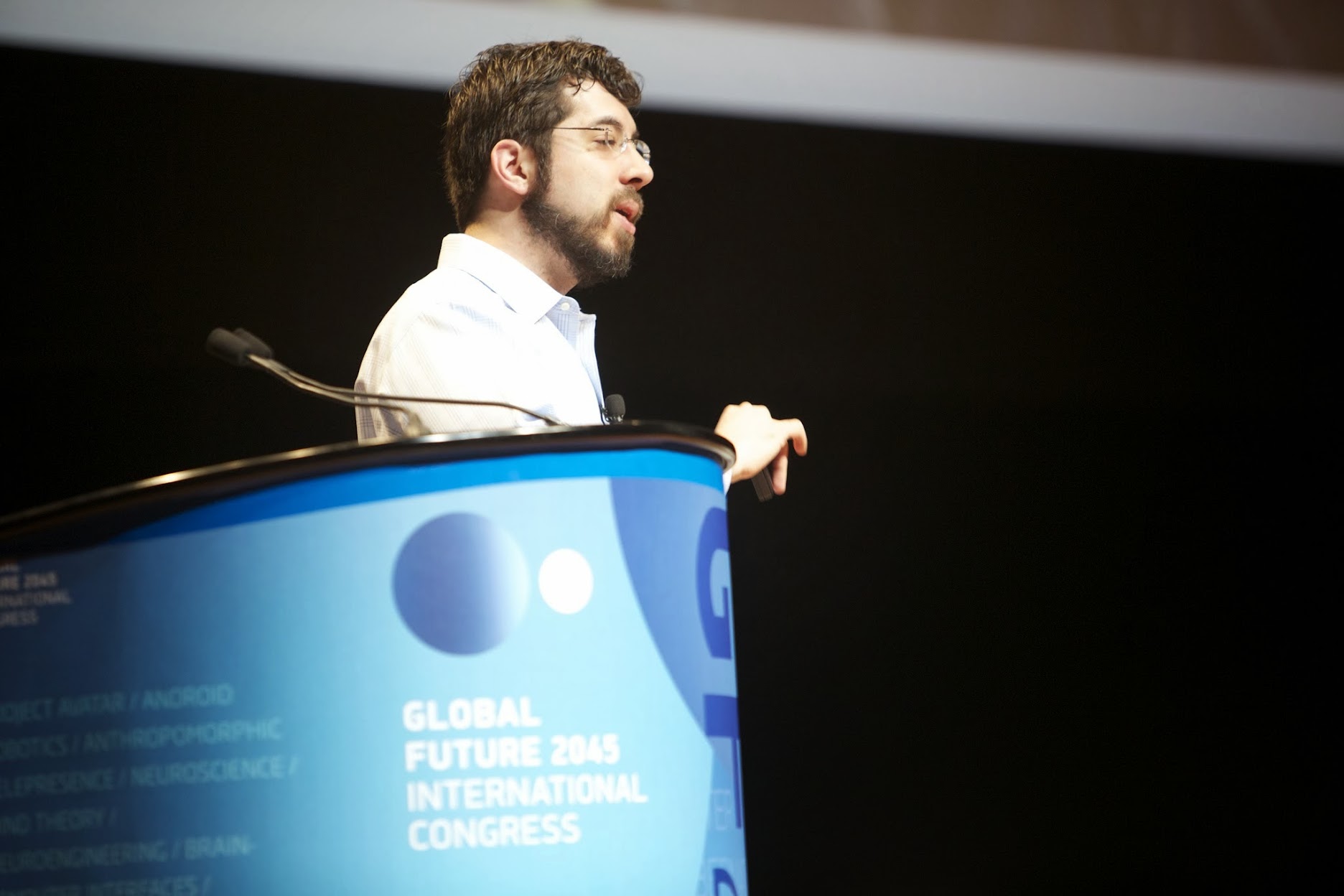
Dr. Ed Boyden, Associate Professor of Biological Engineering and Brain and Cognitive Sciences at MIT
Two talks focused on functional characterization introduced developments within the BRAIN Initiative and new neuroscience tools. Dr. Ed Boyden, Associate Professor of Biological Engineering and Brain and Cognitive Sciences at MIT, in his talk Tools for Analyzing and Engineering the Brain, pointed out that, in order to answer fundamental questions and address medical needs, his group builds new tools and then disseminates them widely. His group has developed automated patch-clamping and ways to analyze many parameters of cells at once (electric, molecular, morphology) in living brains. New 3D arrays enable extracellular recording from and optical stimulation of vast numbers of cells throughout a brain for the study of neural codes and to develop prosthetic neural co-processors for brain regions. Dr. Boyden is well-known as a pioneer of so-called optogenetics. Dr. Boyden also introduced biological neural circuit construction by lithographic processes, stating, “[...] neuroscience can benefit from constructive approaches, where you try to build brains […]"
Dr. Michel Maharbiz, UC Berkeley Associate Professor of Electrical Engineering and Computer Science, elaborated the need for reliable and biocompatible chronic BMI. A first improvement is to make implants completely wireless and flexible. Dr. Maharbiz then announced one of the most exciting proposals of tools for functional characterization, Neural Dust, (Seo et al., Neural Dust: An Ultrasonic, Low Power Solution for Chronic Brain-Machine Interfaces, 2013): Thousands of free-floating independent sensor nodes at micrometer scale detect and report local extracellular electro-physiological data.
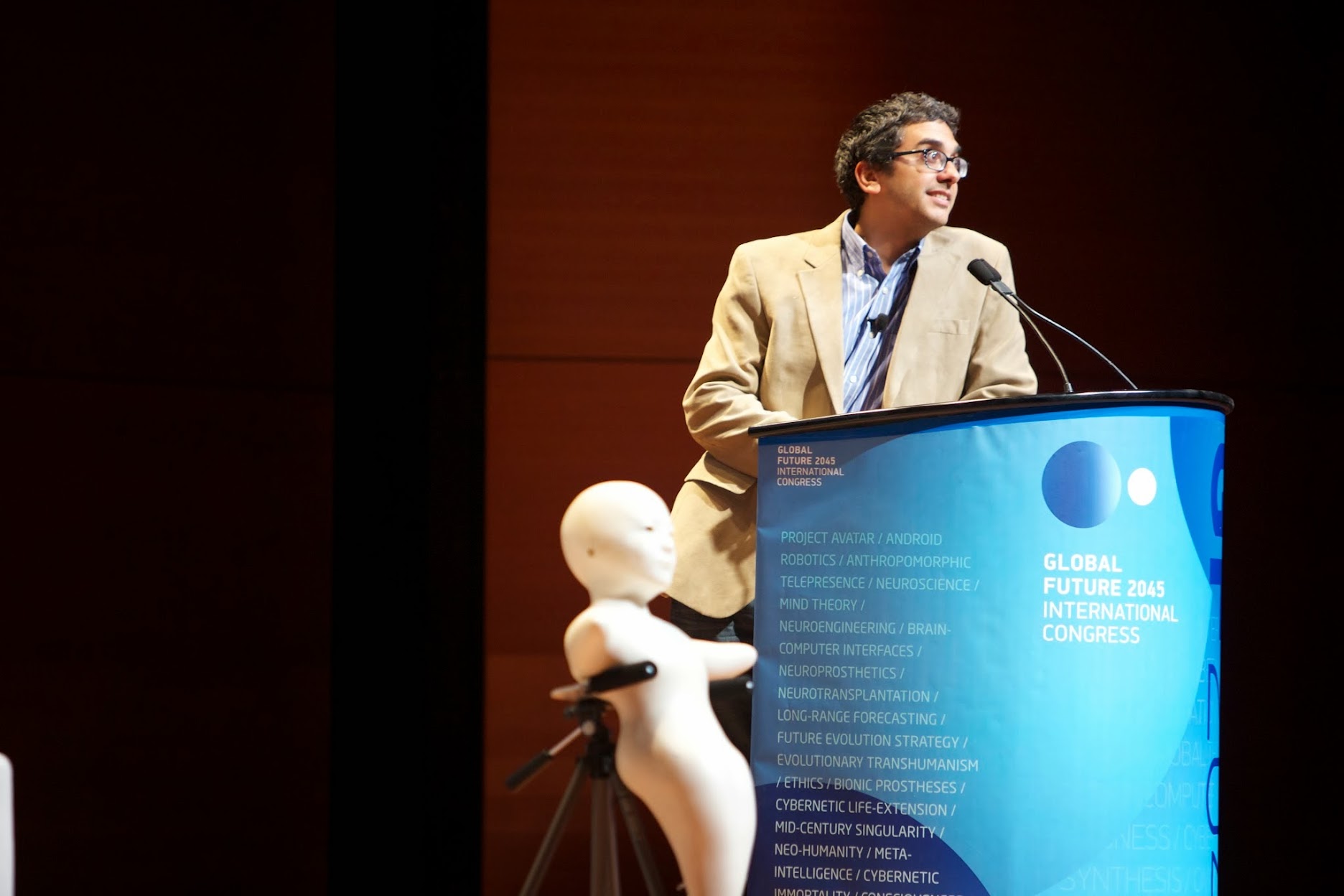
Dr. Michel Maharbiz, UC Berkeley Associate Professor of Electrical Engineering and Computer Science
Variants of the Neural Dust approach were addressed in Dr. Koene's presentation, using integrated circuits on microscopic probes and infrared light for power and communication (MIT, Harvard) within a hierarchy or cloud of specialized devices. Dr. Koene also described additional developments: Connectomics to be done by biological barcoding in work by Dr. Anthony Zador at Cold Sping Harbor Laboratories, the CLARITY protocol by the Deisseroth lab that renders brains light-transparent for microscopy, functional recording by fluorescent microscopy, and the Molecular Ticker Tape approach to functional recording within cells onto strips of synthetic DNA. Some of the most exciting recent develops came out of a June 12 summit at Harvard with the specific aim to identify technologies that could sample every neuron in a brain at 1ms resolution in-vivo (Marblestone et al, Frontiers in Computational Neuroscience, 2013), while WBE itself was recognized as a valid and desirable research target during the Brain Reseachers' meeting that preceded GF2045.
WBE will be preceded by numerous augmentations made possible by new neural interface devices, including detection of stress/anxiety, detection and prevention of epilepsy, control of sleep and waking, direct storage and recall of visual scenes (retinal or visual cortex interfaces), off-line tagging and sorting of episodic memory (hippocampal interfaces), and overcoming paralysis. Judging by the rate of progress in connectomics over the past 5 years, the addition of tools for functional characterization in the next 5 years can mean that, by 2018, commencing a project to analyze and emulate the brain of the fruit-fly Drosophila is feasible.
The 2045 Initiative: A network to accelerate solutions for the global future of humanity
The speakers at GF2045 explored practical requirements in neuroscience and neural engineering, and they proposed and demonstrated technological solutions that, at least in principle, substantiate the scientific and technical feasibility of the strategicAvatar project, as motivated by the goals of the 2045 Initiative. In addition to this necessary scientific grounding and methodical introduction, theoretical work carried out with early funding from the 2045 Initiative was presented at GF2045 in the Current state of the Russian Project on Brain Reverse-engineering REBRAIN 2045, by Dr. Witali L. Dunin-Barkowski, Head of the Neuroinformatics Department at the Center for Optical-Neural Technology. Alternative theoretical considerations regarding brain matter, consciousness and free will were explored in the talk by Dr. Amit Goswami, Professor Emeritus at the Theoretical Physics Department of the University of Oregon, titled Consciousness and the Quantum: Science, Psychology and Spirituality. Dr. Stuart Hameroff, anesthesiologist, professor at the University of Arizona, collaborating with renowned British Physicist, Sir Roger Penrose, presented How Human Consciousness Could Be Uploaded Via Quantum Teleportation.
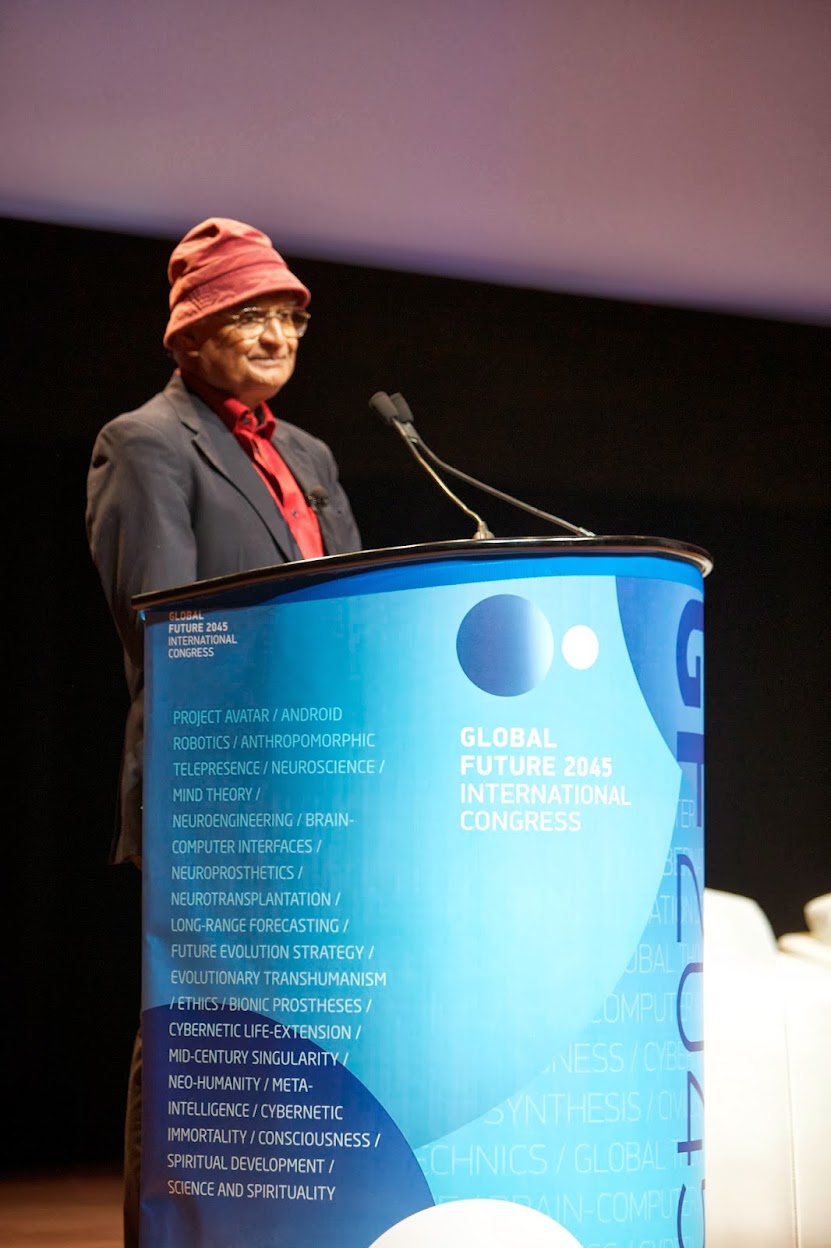
Dr. Amit Goswami, Professor Emeritus at the Theoretical Physics Department of the University of Oregon
The GF2045 congress presented technological achievements, but Mr. Itskov stressed that we should look beyond the individual concepts and technologies presented, at a new evolutionary strategy for humanity. It is a strategy that involves both a spiritual revolution, in that levels of public consciousness and regard for safe and beneficial technology are raised, and a techno-scientific revolution, through the development of personality transfer to an artificial carrier that will become more capable.
Even more so than during the space race, we presently have global economies of scale, a global scientific infrastructure, and technological capacity with which to tackle ambitious problems of our choosing. We cannot know with certainty if we will have that 20, 40 or 60 years from now. While we can, it is our responsibility to take this opportunity to learn more about ourselves and to better ourselves and the outlook for our civilization. Among scientists, it is a good habit to under-promise and to over-deliver, but remember that throughout history the thirst for new discoveries and possibilities has driven scientific inquiry, and so the vision at the foundations of the 2045 Initiative may again help drive the science.
The 2045 Initiative proceeds now, to the next step, by opening our scientific network to global involvement. The Initiative also invites stewards of business to join in the development of our clinical research network for full-body prosthesis, for which the project plan is now available. These activities will bring about a new Cybernetic Industry. At first, there will be opportunity for philanthropy, then there will be opportunity for profitable investment. We invite politicians, public and social figures to help bring about the social change for the Initiative. People need to have a right to live and not to die.
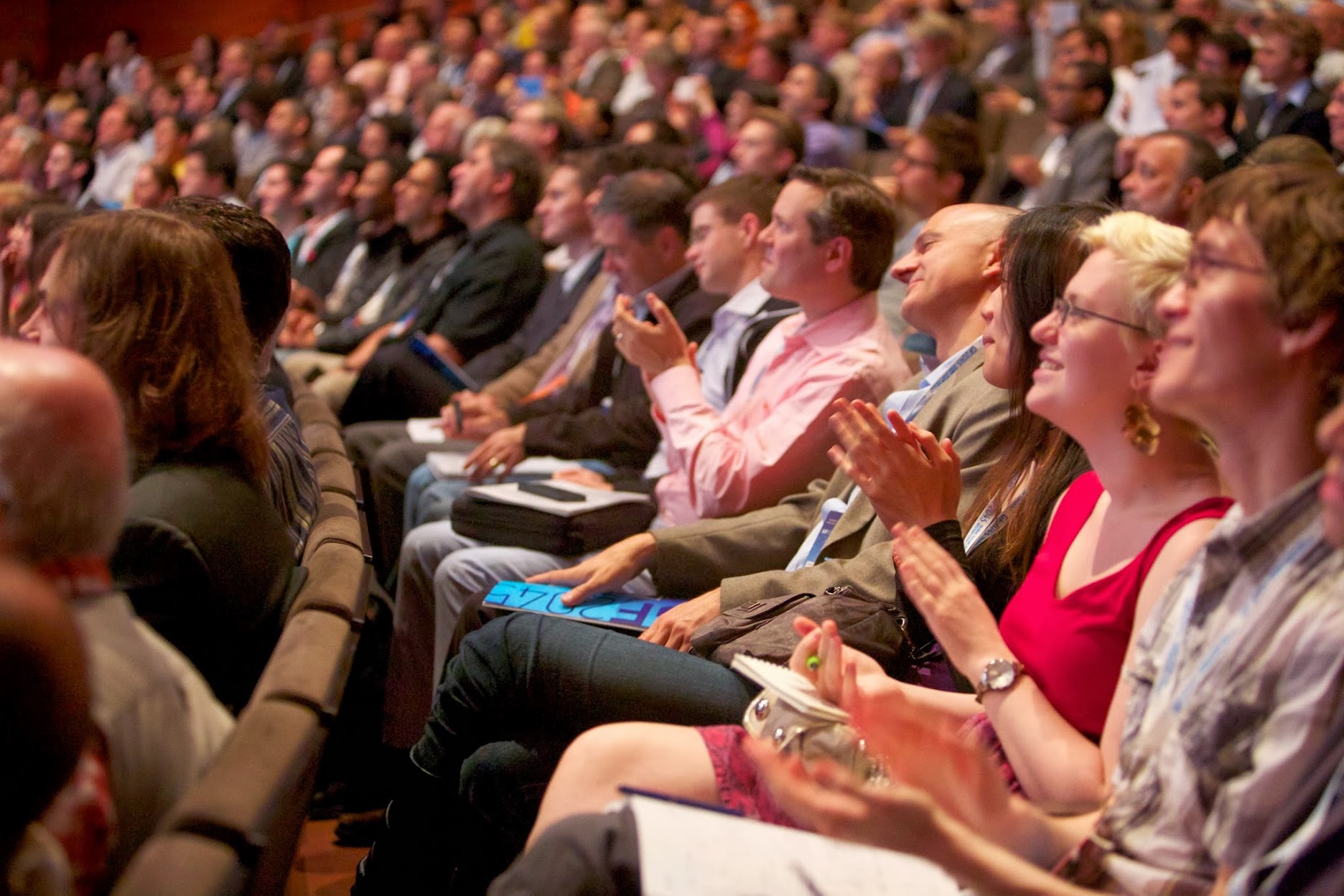
Source: http://gf2045.com/read/265/
/ About us
Founded by Russian entrepreneur Dmitry Itskov in February 2011 with the participation of leading Russian specialists in the field of neural interfaces, robotics, artificial organs and systems.
The main goals of the 2045 Initiative: the creation and realization of a new strategy for the development of humanity which meets global civilization challenges; the creation of optimale conditions promoting the spiritual enlightenment of humanity; and the realization of a new futuristic reality based on 5 principles: high spirituality, high culture, high ethics, high science and high technologies.
The main science mega-project of the 2045 Initiative aims to create technologies enabling the transfer of a individual’s personality to a more advanced non-biological carrier, and extending life, including to the point of immortality. We devote particular attention to enabling the fullest possible dialogue between the world’s major spiritual traditions, science and society.
A large-scale transformation of humanity, comparable to some of the major spiritual and sci-tech revolutions in history, will require a new strategy. We believe this to be necessary to overcome existing crises, which threaten our planetary habitat and the continued existence of humanity as a species. With the 2045 Initiative, we hope to realize a new strategy for humanity's development, and in so doing, create a more productive, fulfilling, and satisfying future.
The "2045" team is working towards creating an international research center where leading scientists will be engaged in research and development in the fields of anthropomorphic robotics, living systems modeling and brain and consciousness modeling with the goal of transferring one’s individual consciousness to an artificial carrier and achieving cybernetic immortality.
An annual congress "The Global Future 2045" is organized by the Initiative to give platform for discussing mankind's evolutionary strategy based on technologies of cybernetic immortality as well as the possible impact of such technologies on global society, politics and economies of the future.
Future prospects of "2045" Initiative for society
2015-2020
The emergence and widespread use of affordable android "avatars" controlled by a "brain-computer" interface. Coupled with related technologies “avatars’ will give people a number of new features: ability to work in dangerous environments, perform rescue operations, travel in extreme situations etc.
Avatar components will be used in medicine for the rehabilitation of fully or partially disabled patients giving them prosthetic limbs or recover lost senses.
2020-2025
Creation of an autonomous life-support system for the human brain linked to a robot, ‘avatar’, will save people whose body is completely worn out or irreversibly damaged. Any patient with an intact brain will be able to return to a fully functioning bodily life. Such technologies will greatly enlarge the possibility of hybrid bio-electronic devices, thus creating a new IT revolution and will make all kinds of superimpositions of electronic and biological systems possible.
2030-2035
Creation of a computer model of the brain and human consciousness with the subsequent development of means to transfer individual consciousness onto an artificial carrier. This development will profoundly change the world, it will not only give everyone the possibility of cybernetic immortality but will also create a friendly artificial intelligence, expand human capabilities and provide opportunities for ordinary people to restore or modify their own brain multiple times. The final result at this stage can be a real revolution in the understanding of human nature that will completely change the human and technical prospects for humanity.
2045
This is the time when substance-independent minds will receive new bodies with capacities far exceeding those of ordinary humans. A new era for humanity will arrive! Changes will occur in all spheres of human activity – energy generation, transportation, politics, medicine, psychology, sciences, and so on.
Today it is hard to imagine a future when bodies consisting of nanorobots will become affordable and capable of taking any form. It is also hard to imagine body holograms featuring controlled matter. One thing is clear however: humanity, for the first time in its history, will make a fully managed evolutionary transition and eventually become a new species. Moreover, prerequisites for a large-scale expansion into outer space will be created as well.
Key elements of the project in the future
• International social movement
• social network immortal.me
• charitable foundation "Global Future 2045" (Foundation 2045)
• scientific research centre "Immortality"
• business incubator
• University of "Immortality"
• annual award for contribution to the realization of the project of "Immortality”.



 LinkedIn
LinkedIn
 LiveJournal
LiveJournal
 Google
Google
 Twitter
Twitter
 Facebook
Facebook
 Я.ру
Я.ру
 ВКонтакте
ВКонтакте
 Mail.ru
Mail.ru